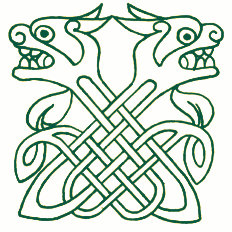Patricia Monaghan and The Encyclopedia of Celtic Mythology and Folklore
 The prolific Patricia Monaghan, at the time of her recent death in November 2012, was Professor at Chicago's DePaul University School for New Learning (America's largest Catholic University). The author of "The Encyclopedia of Celtic Mythology and Folklore", Monaghan is from an Irish American family and held dual citizenship. She was author of over 20 books reflecting a general interest in Celtic and non-Celtic deities, an example being her "Encyclopedia of Goddesses and Heroines" first published in 1981. An author of eclectic interests, Monaghan also penned the 2008 "Wineries of Minnesota and Wisconsin" and at the time of her death at age 66 had just completed an anthology entitled "Brigid: Sun of Womanhood" which is set for 2013 publication.
The prolific Patricia Monaghan, at the time of her recent death in November 2012, was Professor at Chicago's DePaul University School for New Learning (America's largest Catholic University). The author of "The Encyclopedia of Celtic Mythology and Folklore", Monaghan is from an Irish American family and held dual citizenship. She was author of over 20 books reflecting a general interest in Celtic and non-Celtic deities, an example being her "Encyclopedia of Goddesses and Heroines" first published in 1981. An author of eclectic interests, Monaghan also penned the 2008 "Wineries of Minnesota and Wisconsin" and at the time of her death at age 66 had just completed an anthology entitled "Brigid: Sun of Womanhood" which is set for 2013 publication.
We are grateful for Professor Monaghan's interest in spirituality and mythology for it led to the 2004 publication of "The Encyclopedia of Celtic Mythology and Folklore". This work contains over 1000 entries spanning 500 pages which enjoy generous source citations for further reading and covers topics of Celtic mythical heroines, sacred Celtic places and objects, religious concepts and the Celtic pantheon. One of the sacred places cited is Lough Gur near modern Limerick in Ireland, which is the site of the largest extant Stone Circle in Ireland The Grange. This sacred place is believed to be an entrance to the Otherworld, a belief common in Celtic lands where water was seen as the "dividing line between this world and that of the Fairies".
The entry on the ubiquitous Fionn (Finn) MacCool is an example of Monaghan's story telling craft with multiple source text references. MacCool is a symbol of how Celtic mythology has embedded itself in popular culture and whose name is familiar to Pub goers around the world. Finn is the "SuperMan" of Irish Mythology who battles giants, fathers virile sons and who is linked to one woman after another: " Fionn (Finn) is now generally believed to have originally been divine, a status made clear in legends that he created the countryside as part of his activities. He is said to have cut mountains in half with his sword and left scratches where he clung to rocks as he climbed".
The overall content of "The Encyclopedia of Celtic Myth and Folklore" reflects Professor Monaghan's general interests and thus sometimes strays from the central Celtic theme with entries on Roman and Greek deities. This is amply mitigated by the passionate entries on the Celtic divinities such as the goddess Brigid, the Welsh goddess Arianrod, the Fairy Queen Fand and a fascinating entry on the Celtic origins of Guinevere, the wife of King Arthur and mistress of Sir Lancelot. Monaghan characterizes Guinevere as a thinly disguised Welsh goddess and portrays the Arthurian legend as a variant on the Celtic mythical tradition of the King's inaugural marriage to the goddess of sovereignty. Guinevere is cited as the embodiment of the Celtic nation, "a goddess (Sovereignty) who married one King after another, for she was the land itself".
The Introduction affords an effective overview of the historical Celts with a description of how they are portrayed in classical literature by the Romans and Greeks. The Introduction also describes the rich Celtic Oral Tradition which preserved for us through the 5th Century the broad outline of Celtic Mythology. This was followed by the shift to the written tradition following the collapse of the Roman Empire, a shift fostered by the forces of Christian conversion. Professor Monaghan describes the transition from the Oral Tradition to the first Celtic Language texts: "Even after literacy was introduced (in the Celtic lands) it was not widespread and (oral) composition continued. At the same time works held in the oral tradition were written down, so that early Celtic literature was preserved and passed along by a newly literate class; the Monks, who in Christian times took the place of the bards on antiquity". Monaghan continues, "The greatest number of Celtic language texts is Irish, which boasts the distinction of being Europe's third oldest literary language after Latin and Greek".
We highly recommend "The Encyclopedia of Celtic Myth and Folklore" by Patricia Monaghan (1946/2012) and mourn the passing of a force in the struggle to preserve the culture of the Celtic nations.
Get your copy from Amazon.com (US$) or Amazon.co.uk (GB£):
Other articles of interest
Content type:
- Pan-Celtic
Language:
- English





